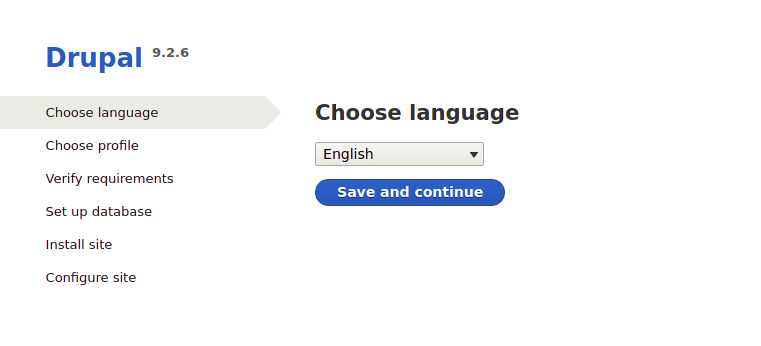
In this tutorial, we will show you how to install Drupal on Fedora 35. For those of you who didn’t know, Drupal is an open-source, flexible, highly scalable, and secure Content Management System (CMS) that allows users to easily build and create websites. It is written in PHP programming language and uses MySQL/MariaDB as a backend database. Drupal is available with thousands of add-ons, which makes it highly customizable.
This article assumes you have at least basic knowledge of Linux, know how to use the shell, and most importantly, you host your site on your own VPS. The installation is quite simple and assumes you are running in the root account, if not you may need to add ‘sudo‘ to the commands to get root privileges. I will show you the step-by-step installation of the Drupal content management system (cms) on a Fedora 35.
Prerequisites
- A server running one of the following operating systems: Fedora 35 or Fedora 34.
- It’s recommended that you use a fresh OS install to prevent any potential issues.
- SSH access to the server (or just open Terminal if you’re on a desktop).
- A
non-root sudo useror access to theroot user. We recommend acting as anon-root sudo user, however, you can harm your system if you’re not careful when acting as the root.
Install Drupal on Fedora 35
Step 1. Before proceeding, update your Fedora operating system to make sure all existing packages are up to date. Use this command to update the server packages:
sudo dnf upgrade sudo dnf update
Step 2. Installing a LAMP Stack.
Before installing Drupal, you must complete the installation of the LAMP Stack on the Fedora system. If you do not have LAMP installed, you can follow our guide here.
Step 3. Installing Drupal on Fedora 35.
By default, Drupal is not available on Fedora 35 base repository. Now we download the latest Drupal version from the Drupal website:
cd /var/www wget -O /tmp/drupal.tar.gz https://www.drupal.org/download-latest/tar.gz
Next, extract the downloaded file:
sudo tar -zxf /tmp/drupal.tar.gz sudo mv drupal-* drupal-app
Then, create a copy of the configuration file from the template. Change to “drupal-app/sites/default” directory and copy the default.settings.php file to settings.php:
cd drupal-app/sites/default sudo cp -p default.settings.php settings.php
After that, we create a folder named ‘files’ in the same directory (drupal-app/sites/default) as settings.php:
sudo mkdir files
We will need to change some folders permissions:
sudo chmod 777 settings.php sudo chmod 775 files/ sudo chown -R www-data:www-data /var/www/drupal-app
Step 4. Configuring MariaDB.
By default, MariaDB is not hardened. You can secure MariaDB using the mysql_secure_installation script. you should read and below each step carefully which will set a root password, remove anonymous users, disallow remote root login, and remove the test database and access to secure MariaDB:
mysql_secure_installation
Configure it like this:
- Set root password? [Y/n] y - Remove anonymous users? [Y/n] y - Disallow root login remotely? [Y/n] y - Remove test database and access to it? [Y/n] y - Reload privilege tables now? [Y/n] y
Next, we will need to log in to the MariaDB console and create a database for Drupal. Run the following command:
mysql -u root -p
This will prompt you for a password, so enter your MariaDB root password and hit Enter. Once you are logged in to your database server you need to create a database for Drupal installation:
MariaDB [(none)]> CREATE DATABASE drupal_db; MariaDB [(none)]> CREATE USER 'drupal_user'@'localhost' IDENTIFIED BY 'your-strong-password'; MariaDB [(none)]> GRANT ALL PRIVILEGES ON drupal_db.* TO 'drupal_user'@'localhost' IDENTIFIED BY 'your-strong-password' WITH GRANT OPTION; MariaDB [(none)]> ALTER DATABASE drupal_db charset=utf8; MariaDB [(none)]> FLUSH PRIVILEGES; MariaDB [(none)]> EXIT;
Step 5. Configure Apache.
Let’s create an Apache configuration file for your domain:
sudo nano /etc/httpd/conf.d/drupal.your-domain.com.conf
Add the following file:
<VirtualHost *:80> ServerAdmin admin@your-domain.com ServerName drupal.your-domain.com DocumentRoot /var/www/drupal-app <Directory /var/www/drupal-app> Allowoverride all </Directory> </VirtualHost>
Save and close the configuration file, then restart the Apache service for the changes to take effect:
sudo systemctl restart httpd sudo systemctl enable httpd
Step 6. Secure Apache with Let’s Encrypt SSL Free Certificate.
First, we install Certbot using the following command below:
sudo dnf install certbot python3-certbot-apache
Then, install the SSL certificate for Apache as below:
sudo certbot --apache
Proceed to an interactive prompt and install the certificate. If the certificate is installed you will see the below congratulatory message:
Congratulations! You have successfully enabled HTTPS on https://drupal.your-domain.com NEXT STEPS: - The certificate will need to be renewed before it expires. Certbot can automatically renew the certificate in the background, but you may need to take steps to enable that functionality. See https://certbot.org/renewal-setup for instructions. - - - - - - - - - - - - - - - - - - - - - - - - - - - - - - - - - - - - - - - - If you like Certbot, please consider supporting our work by: * Donating to ISRG / Let's Encrypt: https://letsencrypt.org/donate * Donating to EFF: https://eff.org/donate-le - - - - - - - - - - - - - - - - - - - - - - - - - - - - - - - - - - - - - - - -
Step 7. Configure Firewall.
Configure the firewall to HTTP port 80 and HTTPS port 443 allow traffic using the following commands below:
sudo firewall-cmd --permanent --zone=public --add-service=http sudo firewall-cmd --permanent --zone=public --add-service=https sudo firewall-cmd --reload
Step 8. Accessing Drupal Web Interface.
Once successfully installed, open your web browser and access Drupal using the URL https://drupal.your-domain.com. You will be redirected to the following page:

Congratulations! You have successfully installed Drupal. Thanks for using this tutorial for installing the Drupal content management system on your Fedora 35 system. For additional help or useful information, we recommend you check the official Drupal website.